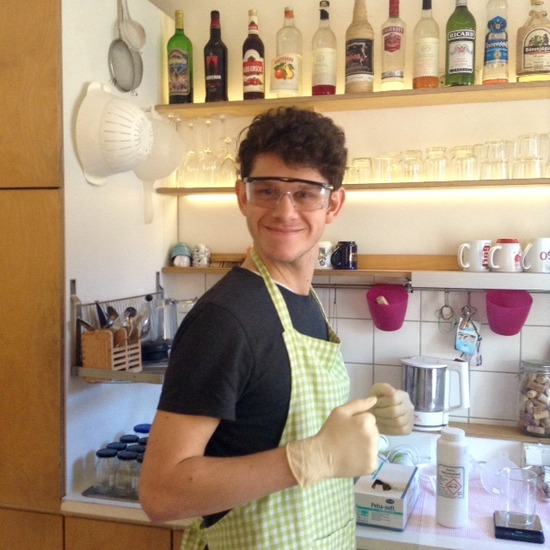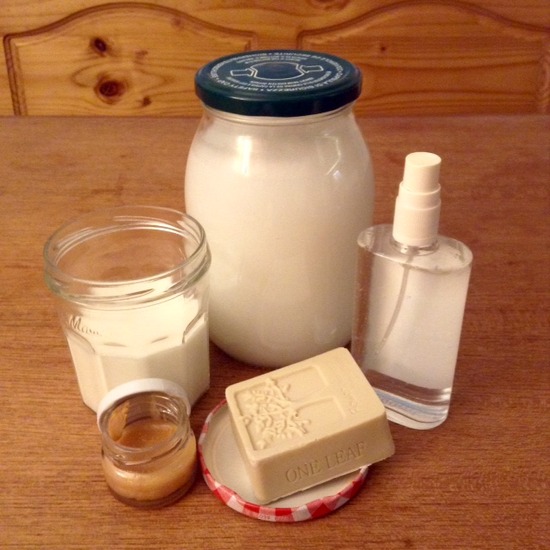Do-It-Yourself in Household and Cosmetic
Producing Daily Consumer Goods in an Experimental Workshop
21.09.2018
Supervisor: Dr. Ursula Münster
Do-It-Yourself (DIY) activities can be found in every aspect of daily life: construction, decoration, repairs etc. In order to reach beyond academic and theorizing frameworks, I chose an experimental workshop where participants and I produced homemade cosmetic and household products. The goal was to create space to exchange ideas, experiences, practices, and critical considerations while we learned some easy strategies to produce ourselves products that one uses on daily basis, with special regard to environmental impacts of such activities. I offered my experiences and recipes, materials and tools, Jennie offered her kitchen, so that the workshop could take place centrally in Munich. All participants chose a perspective which they had to uphold throughout the six-hour workshop and this way make sure that discussions could take place with heterogeneous views. Through participatory research methods the wishes and insights of all participants were evaluated at the beginning, and resulted in the following research positions:
- Considerations on the advantages and disadvantages of individual and communal do-it-yourself activities,
- Calculations on environmental impacts through do-it-yourself activities,
- Holistic view on health advantages of do-it-yourself activities and products,
- A critical view of such activities.
Throughout the workshop, we discussed aspects of these positions, while waiting for chemical reactions to take place or when we had to evaluate between possible ingredients of the next recipe or when different research perspectives collided. I moderated the discussions and filled in the gaps I knew to do so, while on some topics the participants had time to share their insights and knowledge. We produced altogether soap, deodorant, lip balm, hand cream and a washing liquid for the use in washing machines. The discussions were audio-recorded, photos and videos were taken and overall feedback was requested from the participants.
Before diving into production and details of ingredients we discussed motivations for homemade cosmetics and cleaning products. Basic interests were named to be reduction in packaging materials, which usually are made of plastic, non-interest in participating in animal experiments (cruelty free cosmetics), which underlie most products and brands, allergies and autonomy in choosing ingredients, smells and textures, as well as self-determination in choosing the origins and routes of transportation of the ingredients, which impact further on the environment if they are not regional when they definitely could be.

When it comes to choosing between individual or communal production of homemade cosmetics the later seems to have more advantages. Even though in individual production a person has more personalized results with 100% control over the product and its characteristics one also needs to invest in equipment, storage space and acquire the knowledge to produce with satisfying results. Especially when it comes to soap making, one needs to make sure that the kitchen will not become contaminated by the chemicals (NaOH), that children and pets are safe from getting in contact with the reactive materials and that there is a dry and secure space to store the soap while it is becoming ready to use – in the case of 100% olive oil soap this takes up to eight months until the soap can be used. Buying the ingredients for one person use can also easily result in shopping online (which is not a sustainable way of consumption) or driving to specialized stores, which usually can be found in bigger cities and often package small quantities in little plastic bags, which again is not the goal of environmentally friendly production. In a communal production on the other hand, people can specialize on different products which they offer to other community members, shop in bigger quantities and reduce plastic packaging on a larger scale without worry that products expire before being used, reduce costs, develop easier knowledge in depth and community members can support homemade products even if their own life situation does not allow them to get too involved themselves. Producing for a larger group requires to agree on smells, textures, and ingredients so that individual interests cannot always be met without a bigger workload or further storage spaces. But it also allows to recycle more suitable containers, for production and storage of the products, and thus reduce further packaging and costs.
The team that evaluated the overall environmental impact of homemade products came to several considerations partially relating to communal vs. individual production. Shopping the necessary equipment (scales, thermometers, gloves, mixers that have no aluminum parts etc.) for a community or individually already results in big differences concerning resources, as well as the already mentioned plastic reduction when shopping larger quantities and energy costs involved in the production itself.
The overall advantages seem to predominate nonetheless. Since not much time is needed to produce most of the things, it is not unrealistically to sustain oneself through such practices. In six hours of the workshop, we produced fife products for seven people, which of course goes faster in another setting and background. From my experience, it is enough to invest two days a year to cover my needs in creams, facial gels, washing liquids, soaps, deodorants and lip balms for the whole year. Of course one should not forget the origin and transportation of the ingredients. Shea butter, palm oil, cocoa butter, coconut oil, exotic essential oils and alike can be replaced by regional equivalents but most recipes, that are easily found in books or on the internet, will need individual adaptation, which again presupposes certain knowledge of the matter and creativity, as well as personal time. Keeping recipes simple and regional thus has many advantages in homemade products, but need to be created individually. However, there is another important environmental aspect of DIY production: indirectly putting pressure on industries to reduce unnecessary ingredients, which are damaging to the environment, reducing transportation, reducing exotic ingredients, eliminating animal experimenting and recreate packaging materials.
From a holistic health perspective, creating your own products gives you the unique chance to take care of your individual needs and tastes. The fatness of your soap, the smells, the ingredients that will help with skin issues, allergies etc. can all be adapted to your very own situation and thus support you physically and mentally. It can also be a hobby that helps you get in touch with your products, your wishes and reduce the application of cosmetics that are only partially cut out for you and that for a larger financial price on the common market compared to costs of homemade production. It can also increase your awareness of the products and their impact on the environment as well as give you self-determination in supporting environmental causes.
From the critical view, the environmental advantages of homemade products only hold when eliminating exotic ingredients and using ecologically produced ingredients for larger groups of people. Especially the time intense and costly start into such activities can be a stop for many people to even begin considering homemade products. But these evaluations are not the same for all products. Making your own soap, for example, requires some tools, vegetal oils of your choice and NaOH. You can use a milk carton as a storage container and cut the soap up, once it is ready, with a knife. In this case, the only plastic in the process will be the container of NaOH, which will last you for about ten years if you produce your own soap for your household, the mixer handle, and the laser thermometer. The result, however, can cover your liquid washing usage, shower gels, dishwashing liquid, shampoo and alike, though of course with different recipes. Producing lip balms on the other hand is a very simple process, in about ten minutes you produce ten lip balms that hold for over nine months but are either poured in plastic tubes or in glass containers that are less hygienically since you need to dip in each time you use it with probably not always clean fingertips.
Overall can be said, that those who already shop and consume environmentally consciously, tend to use for example olive or coconut oil as a cream, or use body soap for hair and body and that way reduce plastic packaging and extra products. Those people can best profit from homemade products when produced communally and based on the soap since it has multifunction in daily use with little plastic involved altogether. Others might not be that much interested in investing time, acquiring knowledge of ingredients and their origins and so forth. Workshops, on the other hand, can serve as a sensitization which can help people to reconsider their consumption patterns and consequently influence industries to participate in environmentally friendly production and packaging. Thus homemade products are a matter of sensitization, activism, and autonomy, as well as a shared identity for participants of DIY activities and civic engagement in the political.

The Workshop, the preparation, and duration were somewhat challenging. First of all, it was hard to estimate how many participants would appear, but the ingredients needed to be bought for the proper amount of participants. Furthermore, it was difficult to know the duration since I never held such a workshop before and especially not in the experimental and participatory style. All together I perceived it to be a productive and interactive experience which shed light on some of the involved perspectives and roles homemade products can take.

